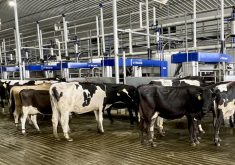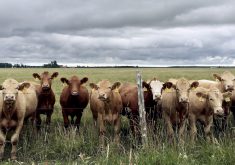Add the adjective, and you add the margin.
A simple bit of advice, but bringing differentiation into the red meat market is essential for grabbing consumer attention.
Dr. David Hughes shone a light on the beef sector marketing disconnect during the Beef Farmers of Ontario (BFO) 59th virtual annual meeting in February.
Read Also

BinSentry sensors reduce feed-bin outages
BinSentry sensors mean fewer feed bin outages and more efficient deliver for feed mills.
Why it matters: Red meat needs an image overhaul that highlights its health benefits, environmental stewardship and climate change benefits to rebuild consumer confidence in their products, says one speaker.
The beef sector must modernize its marketing approach or lose market share opportunities to those who do, said Hughes, an emeritus professor of Food Marketing at Imperial College London, United Kingdom.
“How do you like your beef? The answer is, I’d like my beef with adjectives, please,” he said. “I don’t think there’s much margin in the noun beef. I think the margin is in the adjectives.
“Ontario, corn-fed, grass-fed, clover-fed, Farmer Joe’s, Clear Creek Farms, Cape Grim, Aberdeen Angus, sustainably grown beef, organic, new season, happy, dry age, antibiotic-free,” Hughes rhymed off as examples.
Adjectives not only sell the product, but they also sell the story and consumers, especially in the COVID-19 and post-pandemic world, want to connect to their food, he said.
In the last two years, JBS, the largest global meat company, launched a whole raft of brands with different adjectives associated with their product, said Hughes, adding the rest of the industry needs to catch up.
Hughes pointed to Waitrose brand bacon as an example in marketing to the new consumer.
“My local Waitrose premium retailer, as I say, owns college-educated pigs exclusively used for Waitrose premium bacon,” he said. “Because it’s gourmet, free-range, air-dried, beechwood smoked and cured in Suffolk. In England, we’re willing to pay more for those adjectives.”
Marketing requires more than colourful adjectives to engage and capture a market share of millennial consumers and younger demographics, he said.
Hughes suggested instead of railing against plant and cell-based meat alternatives, take a hard look at why their marketing is so successful.
The Vegetarian Butcher, owned by Unilever, positions its products with a young, well-educated, higher-income consumer in mind, often focusing on a mother with young children.
Products with schoolboy-ish names like Little Willies, What the Cluck, UnbelievaBull burgers, and Little Peckers, are consumer-focused and reflect demand-pull, whereas, red meat products are production-led and driven by supply-push, he said.
“We need to work on more consumer-friendly product names and product forms on the retail shelf that look less like traffic accidents,” said Hughes. “In every (U.K.) supermarket, there’s always a lamb product that is called half shoulder of lamb knuckle end. This is 2021 – what’s that name? It looks like the aftermath of an appalling axe murder. It has to go.”
Value-added lessons
Hughes said last year, the New Zealand Minister of Agriculture launched a new vision and strategic direction for 2030, which the Ontario beef sector could implement.
“What did they say? Add value,” said Hughes. “We need to be very clear that we are not a volume producer, and we should stop acting like it. Selling commodities in undifferentiated markets is a race to the bottom.”
The sector would be better-served marketing to niches where a razor-sharp focus remains on providing and capturing value. Hughes said the ability to tell the consumer why Ontario beef is worth paying a premium is crucial. Consumer buy-in is non-existent without it.
“You have to explain why it’s worth more. You need more than the noun beef – you need adjectives that ring true with consumers,” he said. “Who understands it, and say, yes, that gives me a good reason to pay more.”
The best market for Ontario beef is its home market, said Hughes.
The province provides a relatively large population of high-income earners, relative to world standards, and consumers interested in being educated in the Ontario beef story.
“I think the local market will just get stronger and stronger and stronger (post-COVID-19),” said Hughes. “You need a good story and, what’s more, the story you have at home isn’t necessarily the story . . . for the export market. Because it’s very different consumers.”















